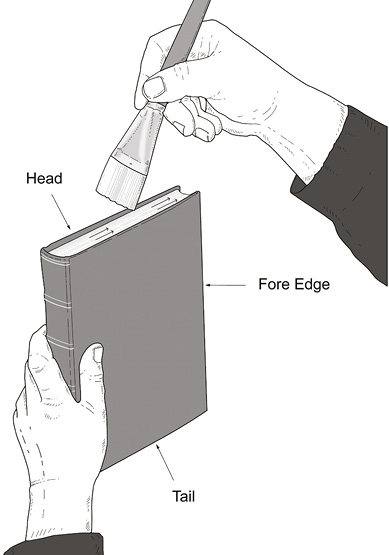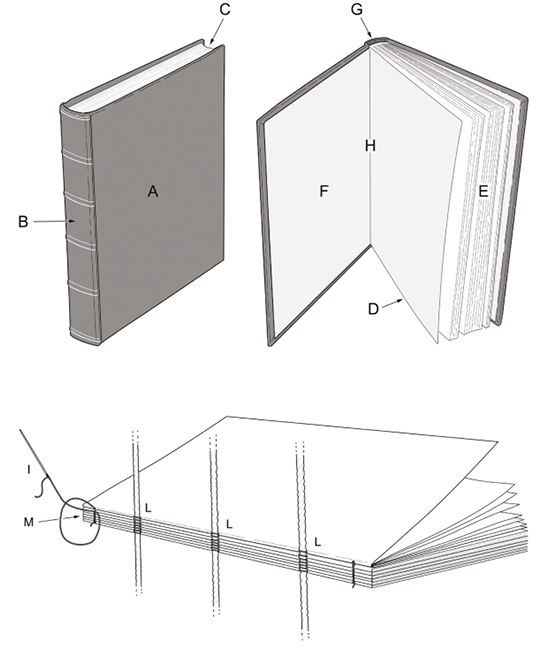4. Collection care and document handling
© Flavio Marzo, CC BY 4.0 https://doi.org/10.11647/OBP.0138.04
Although the main focus of this book concerns the task of digitisation, the safety and care of the target collections is paramount. This chapter therefore provides a brief outline of conservation principles and methods.
General considerations for safe handling of library material
The primary aim of safe handling within digitisation projects is to minimise any further deterioration of the items being digitised.
- All handling has the potential to cause damage by exposing items to some level of wear and tear.
- Don’t rush. Damage can be caused if items are roughly handled when trying to hurry.
- Always lift items rather than push or drag them across surfaces.
- Handle items as little as possible and assume all items are fragile and handle accordingly.
- Don’t lift or carry too much by hand.
- Keep your working space tidy and free from food and drink.
The document proprietors did not allow unbinding of volumes, so the originals were captured as if pages of a book. The originals were returned in the same condition as we had been given them. This kind of behaviour was important to affirm archival partner confidence.
Fernando Valle, EAP726, Peru
• Hands should be clean, dry & free from grease. Oils from balm can cause stains if transferred to items.
• Wearing gloves, especially cotton ones, reduces manual dexterity and the sense of touch, increasing the tendency to ‘grab’ items, thus increasing the risk of damage. Gloves can pick up dirt and transfer it to other items and to imaging devices, which often makes washing hands more effective.
• Gloves should be used when handling certain materials, like lead seals and metal objects, or when touching varnished surfaces, as in the case of globes. Gloves (nitrile gloves are advisable) are sometimes used when viewing photographs that, whenever possible, should be housed in protective sleeves or mounts to avoid direct contact with the fingers. Nitrile gloves are also recommended when handling negatives and glass plates.
• The British Library’s Medieval manuscripts blog hosts a useful post that discusses this more fully and includes links to a video and further advice: http://blogs.bl.uk/digitisedmanuscripts/2011/08/white-gloves-or-not-white-gloves.html
Dust on items can compromise the quality of the digital surrogate. Extensive treatments should not be carried out by non-professional conservators, but light surface cleaning can be easily done by photographers or general project staff. Superficial dirt can be removed by brushing it with soft hair brushes. Always be careful to avoid abrasion of the surface being cleaned. When brushing the outside of bound volumes, the edges of the book-block need to be brushed from the spine towards the fore-edge of the book, avoiding piling dirt against the leather cover or even damaging the head or tail of the binding.
Figure 32. Diagram showing the correct brushing direction for a bound volume. Illustration © Anne Leaver, CC BY 4.0.
Pictures and glass plate negatives
Handling. Always wear protective gloves, possibly made of nylon or latex, when handling glass plate negatives or pictures to avoid mechanical damage, such as breakages, fingerprints, and scratches. In addition to helping prevent contaminants (such as oils or acids from skin) being transferred to the plates, wearing gloves also protects hands from their potentially sharp edges.
Minimal cleaning. Keep cleaning to a minimum. Remove accumulated dust and surface dirt with a soft brush. Do not treat glass plate negatives with organic solvents, such as alcohol, or in aqueous solutions to clean them. To remove the majority of this dirt, the plates can be lightly dusted with a soft brush or a hand-held bulb duster (air blower) before digitisation. However, it is important to consider the condition of the glass plate before dusting, as dusting can damage the image if the emulsion is deteriorating or flaking.
Imaging. To help prevent possible particles of dust from scratching the plates or even the glass of the scanner, a transparent Mylar or acetate sheet can be placed over the scanner bed. This, together with taking care when placing plates onto the scanner, will protect both the scanner glass and the plates from being damaged.
Glass plate negatives (see page 78) can break due to the pressure exerted on them by the lid of the scanner during their digitisation. This can be avoided by raising the hood of the scanner slightly (approx. 1–5mm is ideal) if the lid opening can be adjusted, or by placing felt, foam, or cardboard strips around the edges of the scanner bed to cushion and lift the lid. This will also remove the risk of the plate being sucked up and dropped (due to the glass-on-glass suction effect) by the hood when the scanner is opened.
Archival files can be made entirely of loose pages or can be fastened together. Fastenings like treasury tags, metal clips, pins or tapes can slow down the imaging process and endanger items during handling (e.g. by tearing the paper as pages are turned). It is thus advisable, sometimes, to remove them. The removal of fastenings may increase the risk of misplacement, dissociation and looting of pages but will make their handling safer.
Housing the files in new folders when fastenings are removed is a good way to mitigate those risks. A good quality four-flap folder, even if it does not entirely remove the threats mentioned, will mitigate them and guarantee much safer future storage for the now loose-leaf items.
Bound items can be challenging to digitise due to their complex structural nature. Opening them can be difficult due to tight sewing or thick spine lining, and this can make the digitisation challenging or even impossible, since the integrity of the items should always be of paramount consideration.
Figure 33. Book diagram and book binding terminology.(A) Board (this drawing relates to western style bindings where the left board is at the front. In Islamic style bindings, where the text is from right to left, this is reversed); (B) Spine (the drawing depicts three raised bands and four panels); (C) Head-edge of the book-block; (D) Tail-edge of the book-block; (E) Fore-edge of the book-block; (F) Left inner board; (G) Head-band (end-band at head) with head-cap (end-cap at head); (H) Left inner joint; (I) Sewing thread with needle; (L) Sewing supports (single cords); (M) Sections. Illustrations © Anne Leaver, CC BY 4.0.
To minimise the handling of bound items only one page should be photographed at a time. All the margins and the gutter of the page should be visible. Also, where possible, the sewing thread passages (middle of the section) should be visible, information that could be used as visual reference for the location of the shot within the quire (a bound section of the book) and the virtual reconstruction of a bound volume.
The sequence of shots, to minimise handling, should be done from the front to the back cover (all the rectos of the folios) and subsequently from back to front (all the versos), so that the volume is turned over only once.
A book support should always be used to hold a bound volume in place and to keep the opening at a suitable angle that enables image capture without straining or damaging the book structure.
- To keep a bound volume opened comfortably to an angle never wider than 120 degrees.
- To restrain the opening, without causing damage (abrasion/tears) to the pages during imaging, while helping the photographer to turn them easily and efficiently.
- To move the entire volume, already secured onto the support, without having to drag it on the table surface.
‘Housing’ refers to the mode of storage for any given document, whether a box, folder, or indeed anything else in which it is kept. It is essential to be able to achieve the best environment for the items, but without wasting time or resources — both of which can be very limited when working in the field or other remote circumstances. Customisable, archival-quality storage is a good solution to many issues and can improve the long-term preservation of items without the need for a great investment of time and money.
The archival quality of the materials a storage device is made of is the result of a production process that guarantees their long-term chemical and physical stability. Acid-free is a common label for this type of material, especially referring to paper and board, although it is by no means the only specification required for them to meet international standards such as ISO 16245:2009 or ISO 9706:1994. Other than paper and board, polyester film (Mylar, Melinex) and Tyvek are well-established preservation materials.
- Ready-made new folders can be acquired; folders need to be strong but easy to use and simple to assemble. Four flap folders made of light archival board with string and button(s) are very good; those folders need to have many ready-creased lines along the flaps so that they can be folded to the size of the object they have to contain, thus wrapping it tightly.
- When an item is not being used, it should be kept in its box or folder. The folder enclosures need to be tightly secured to avoid any movement inside, but at the same time, they should not be so tight that the excessive pressure causes the item to become distorted.









